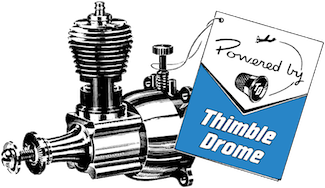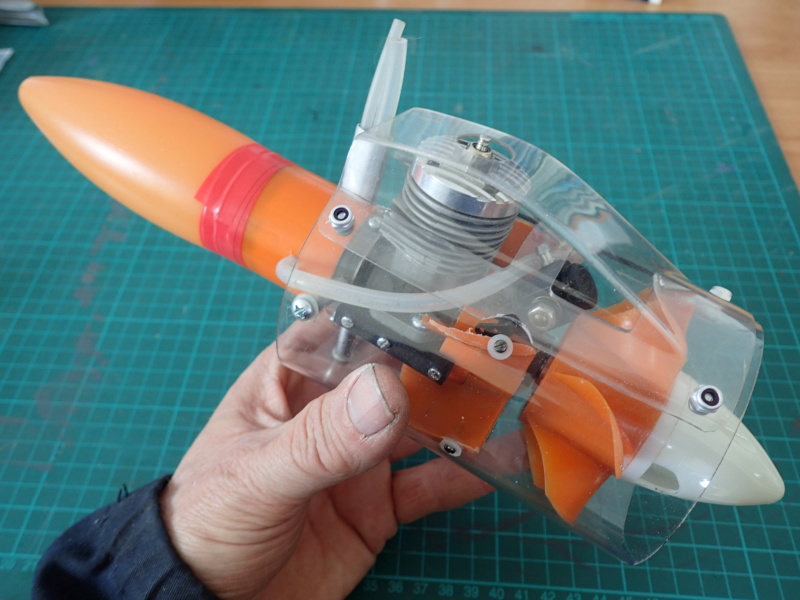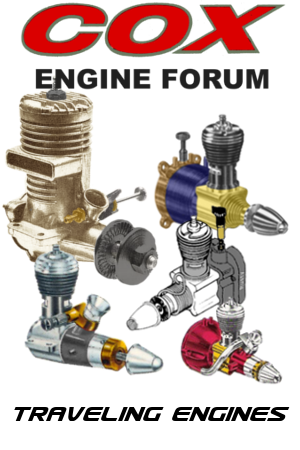Log in
Search
Latest topics
» Tired of it all…by batjac Today at 3:06 am
» Three -- sold out (making two more) Cox .010 Carburetors with wrench
by balogh Today at 12:34 am
» Joe Wagners Sioux
by GallopingGhostler Yesterday at 9:03 pm
» Roddie's flat-bottomed boat..
by rsv1cox Yesterday at 6:26 pm
» Happy Anzac Day!
by GallopingGhostler Yesterday at 4:16 pm
» Jim Walkers FireBee - This is going to be fun
by rsv1cox Yesterday at 12:27 pm
» Project Cox .049 r/c & Citabrian Champion
by rdw777 Yesterday at 8:14 am
» Revivng Some Childhood Classics
by getback Yesterday at 7:31 am
» Fox .35 Modifications
by Ken Cook Yesterday at 3:16 am
» Introducing our Cox .049 TD Engines
by getback Fri Apr 26, 2024 6:20 am
» Cox powered jet-pump for model Sprint Boat
by roddie Thu Apr 25, 2024 10:25 pm
» Micro Draco Gets to Fly on a Beautiful Morning.
by rdw777 Thu Apr 25, 2024 8:15 pm
Cox Engine of The Month
Cox PT-19 history
Page 1 of 1
 Cox PT-19 history
Cox PT-19 history
I ran across this post and thought it would be a interesting read.
Hello Everyone,
I got the bug for PT-19 trainers during Christmas in 1970. My Father and Uncle received a PT-19 each as a gift from my grandparents that year. I was 5 and was more than a little unhappy that I didn’t get an Airplane. Dad flew his twice if you can call it that. He made it off the ground straight up and back into the ground. The 2nd event was after much urging from me and a trip by my mother to purchase a new fuselage and I think.. Wing. I visited by the baseball diamond where this 2nd crash happened last week. 36 or so years later. I think I need to go fly mine there just settle the score if you will.
I bought a PT-19 in the late 70’s and surprisingly enough flew it successfully and often. I had a blast. Dad was always surprised that it came home intact. Somewhere along the lines this all faded and it was sold at a garage sale or something. I think Dads went the same way.
Last year I got the control line bug. I bought a PT-19 at the flea market for 12.50 in the original box. This was a 1962 plane and one I had not seen before. I started working to find these and now have a “sort of” collection with a 5th version as I call it that I am flying currently. I am going to put together an early version from all the spare parts to fly something with the Baby Bee.
I bought Dad an un flown (4th version) 1974 plane last year and gave it to him for Christmas last year. My son who I plan on teaching to fly this weekend received a 6th version although its really not the same plane anymore.
Below is what I know so far excluding anything like Red/White or muffled versions. It is interesting when you are making sure a particular plane has all the correct period parts how much they changed. Some of the information below may be incorrect but I have joined this blog as it looks like the correct group of folks are here to further clarify the details. I can shoot photos of anything I have to make comparisons. Perhaps we can also do some trading of sought after items back and forth to complete these little gems.
Here is what I have compiled so far. Mark
1st version - 1960-1965
Motor –Baby Bee with Thimble Drone etched into the aluminum tank.
Firewall – Tank mounted motor and opposite the color of the fuselage. Tab on the back to indicate the angle of the motor. Beginner-Advanced.
Fuselage – Open at the front to allow motor to tip out during crash. No reinforced areas and very thin and light.
Note: The earliest version of Fuse in 1960-61 has far less panel line detail present. The initial lines are there but that is it.
Pilots - assembled from 2 pieces. Left and Right halves with mounting tabs on the shoulders. They were not painted and were injected in the color opposite the fuselage.
Windshields – separate units attached to the top of the fuselage with two tabs to locate. Plastic welded.
Color: The yellow was a more Canary Yellow and the blue has a grayness.
2nd version – 1966-1970
Motor –Baby Bee with Thimble Drone etched into the aluminum tank for early portion of the run. Toward the end this etching was not on the tank.
Firewall – Tank mounted motor and opposite the color of the fuselage. Tab on the back to indicate the angle of the motor. Beginner-Advanced.
Fuselage – Open at the front to allow motor to tip out during crash. No reinforced areas and very thin and light. Panel and rivet detail continued from the 62 and on version. Toward the end of the run for this model the area around the motor may be trimmed away more to alleviate warping from exhaust.
Pilots - assembled from 2 pieces. Left and Right halves with mounting tabs on the shoulders. Painted but with the color of the plastic that they were molded from left exposed as the color of the shirt they were wearing. One guy in a Blue shirt and the other in Yellow per plane.
Windshields – separate units attached to the top of the fuselage with two tabs to locate. Plastic welded.
Color: The yellow changed and was a more standard and darker or school bus yellow and the blue changed to a lighter Blue.
3rd version – 1970-1973
Motor –Baby Bee with integral tank as on earlier versions.
Firewall – Tank mounted motor and opposite the color of the fuselage. Tab on the back to indicate the angle of the motor. Beginner-Advanced.
Fuselage – Same but with a cross bar added to join the left and right sides in front of the motor. Also the opening for the motor is smaller if looking at it from the top.
Pilots - assembled from 2 pieces. Left and Right halves with mounting tabs on the shoulders. Painted with the color of the plastic that they were molded from left exposed as the color of the shirt they were wearing. One guy in a Blue shirt and the other in Yellow per plane.
Windshields – separate units attached to the top of the fuselage with two tabs to locate. Plastic welded.
Wing- Rubber band posts are reinforced somewhere during this run.
Color: Same as version 2
4th version – 1974-Motor –Initial version had Baby Bee but changed to a motor with a plastic back plate. Primarily In Red plastic
Firewall – Tank mounted motor became unit with a plastic back plate and required a different and deeper firewall to make up the difference in length. Yellow in color. May be a blue. Not sure but all eventually became black.
Fuselage – Initial units had no integrated tank for Baby Bee but changed to integral tank. Initial filler and overflow nipples were the same size in front of the windshield and later changed to 1 nipple with a larger overflow and floating valve out of black plastic. Side lugs were added for to strap rubber bands under the wing from front to back.
Tank: Molded in plastic matching the fuselage with an offset triangular shape to drain fuel on the right side and keep motor fed using centrifugal force.
Pilots /Windshields – Assembled a complete and separate interior that included the windshields. Mounted from inside on two posts that were mushroomed with heat to keep this in place. Heads were larger and shirts on the pilots were orange. This was a more complete pilot with full torso. Instruments are a sticker on the dash.
Elevator – 2nd position and slower adjustment for pushrod added. This may have been added during the end of the 3rd version.
Color: Blue became darker.
5th version – Early 80’s
Motor – Motor with a plastic back plate.
Firewall – Deeper firewall continues to make up the difference in length from the Baby Bee. Black in color.
Tank: Molded in clear/white plastic much like a film canister and now round in shape with an offset single nipple drain. No longer triangular in shape and motor can starve during nose up situations.
Fuselage – Completely different fuselage. rivet detail and lines have changed although it looks traditional. Windshields are only a very vertical frame and Pilots shoulders are formed into the back of the cockpit. Big Dudley Do-right heads that are heat welded in place from below. The heads nearly always break off. Overall a thicker and more durable fuselage.
Color: Same Darker Blue and the yellow is school bus or safety yellow.
Personal note: Controls – Had to modify up down controls by changing the length of the pushrod and trimming the bell crank (clearance) to get the same movement as in earlier PT-19s. Had “no” down initially.
6th version – Early 90’s
Motor –Cox Sure Start.
Firewall – Deeper firewall but this version is different to clear the snorkel on the Sure Start motor and the wire on the landing gear is formed differently.
Tank: Round tank continues. Does not stay attached to the fuselage. Pops off easily.
Fuselage – Again different with increasingly cruder detailing. Opening for the bell crank changed with rounded windows for strength. Pilots are molded in as well on this version but even a step cruder on the detail
Wing- Much thinner and very flexible with a Tip weight.
Rudder: Will not transfer to older PTs and does not locate the same.
Color: A little darker blue and school bus yellow continues
Hello Everyone,
I got the bug for PT-19 trainers during Christmas in 1970. My Father and Uncle received a PT-19 each as a gift from my grandparents that year. I was 5 and was more than a little unhappy that I didn’t get an Airplane. Dad flew his twice if you can call it that. He made it off the ground straight up and back into the ground. The 2nd event was after much urging from me and a trip by my mother to purchase a new fuselage and I think.. Wing. I visited by the baseball diamond where this 2nd crash happened last week. 36 or so years later. I think I need to go fly mine there just settle the score if you will.
I bought a PT-19 in the late 70’s and surprisingly enough flew it successfully and often. I had a blast. Dad was always surprised that it came home intact. Somewhere along the lines this all faded and it was sold at a garage sale or something. I think Dads went the same way.
Last year I got the control line bug. I bought a PT-19 at the flea market for 12.50 in the original box. This was a 1962 plane and one I had not seen before. I started working to find these and now have a “sort of” collection with a 5th version as I call it that I am flying currently. I am going to put together an early version from all the spare parts to fly something with the Baby Bee.
I bought Dad an un flown (4th version) 1974 plane last year and gave it to him for Christmas last year. My son who I plan on teaching to fly this weekend received a 6th version although its really not the same plane anymore.
Below is what I know so far excluding anything like Red/White or muffled versions. It is interesting when you are making sure a particular plane has all the correct period parts how much they changed. Some of the information below may be incorrect but I have joined this blog as it looks like the correct group of folks are here to further clarify the details. I can shoot photos of anything I have to make comparisons. Perhaps we can also do some trading of sought after items back and forth to complete these little gems.
Here is what I have compiled so far. Mark
1st version - 1960-1965
Motor –Baby Bee with Thimble Drone etched into the aluminum tank.
Firewall – Tank mounted motor and opposite the color of the fuselage. Tab on the back to indicate the angle of the motor. Beginner-Advanced.
Fuselage – Open at the front to allow motor to tip out during crash. No reinforced areas and very thin and light.
Note: The earliest version of Fuse in 1960-61 has far less panel line detail present. The initial lines are there but that is it.
Pilots - assembled from 2 pieces. Left and Right halves with mounting tabs on the shoulders. They were not painted and were injected in the color opposite the fuselage.
Windshields – separate units attached to the top of the fuselage with two tabs to locate. Plastic welded.
Color: The yellow was a more Canary Yellow and the blue has a grayness.
2nd version – 1966-1970
Motor –Baby Bee with Thimble Drone etched into the aluminum tank for early portion of the run. Toward the end this etching was not on the tank.
Firewall – Tank mounted motor and opposite the color of the fuselage. Tab on the back to indicate the angle of the motor. Beginner-Advanced.
Fuselage – Open at the front to allow motor to tip out during crash. No reinforced areas and very thin and light. Panel and rivet detail continued from the 62 and on version. Toward the end of the run for this model the area around the motor may be trimmed away more to alleviate warping from exhaust.
Pilots - assembled from 2 pieces. Left and Right halves with mounting tabs on the shoulders. Painted but with the color of the plastic that they were molded from left exposed as the color of the shirt they were wearing. One guy in a Blue shirt and the other in Yellow per plane.
Windshields – separate units attached to the top of the fuselage with two tabs to locate. Plastic welded.
Color: The yellow changed and was a more standard and darker or school bus yellow and the blue changed to a lighter Blue.
3rd version – 1970-1973
Motor –Baby Bee with integral tank as on earlier versions.
Firewall – Tank mounted motor and opposite the color of the fuselage. Tab on the back to indicate the angle of the motor. Beginner-Advanced.
Fuselage – Same but with a cross bar added to join the left and right sides in front of the motor. Also the opening for the motor is smaller if looking at it from the top.
Pilots - assembled from 2 pieces. Left and Right halves with mounting tabs on the shoulders. Painted with the color of the plastic that they were molded from left exposed as the color of the shirt they were wearing. One guy in a Blue shirt and the other in Yellow per plane.
Windshields – separate units attached to the top of the fuselage with two tabs to locate. Plastic welded.
Wing- Rubber band posts are reinforced somewhere during this run.
Color: Same as version 2
4th version – 1974-Motor –Initial version had Baby Bee but changed to a motor with a plastic back plate. Primarily In Red plastic
Firewall – Tank mounted motor became unit with a plastic back plate and required a different and deeper firewall to make up the difference in length. Yellow in color. May be a blue. Not sure but all eventually became black.
Fuselage – Initial units had no integrated tank for Baby Bee but changed to integral tank. Initial filler and overflow nipples were the same size in front of the windshield and later changed to 1 nipple with a larger overflow and floating valve out of black plastic. Side lugs were added for to strap rubber bands under the wing from front to back.
Tank: Molded in plastic matching the fuselage with an offset triangular shape to drain fuel on the right side and keep motor fed using centrifugal force.
Pilots /Windshields – Assembled a complete and separate interior that included the windshields. Mounted from inside on two posts that were mushroomed with heat to keep this in place. Heads were larger and shirts on the pilots were orange. This was a more complete pilot with full torso. Instruments are a sticker on the dash.
Elevator – 2nd position and slower adjustment for pushrod added. This may have been added during the end of the 3rd version.
Color: Blue became darker.
5th version – Early 80’s
Motor – Motor with a plastic back plate.
Firewall – Deeper firewall continues to make up the difference in length from the Baby Bee. Black in color.
Tank: Molded in clear/white plastic much like a film canister and now round in shape with an offset single nipple drain. No longer triangular in shape and motor can starve during nose up situations.
Fuselage – Completely different fuselage. rivet detail and lines have changed although it looks traditional. Windshields are only a very vertical frame and Pilots shoulders are formed into the back of the cockpit. Big Dudley Do-right heads that are heat welded in place from below. The heads nearly always break off. Overall a thicker and more durable fuselage.
Color: Same Darker Blue and the yellow is school bus or safety yellow.
Personal note: Controls – Had to modify up down controls by changing the length of the pushrod and trimming the bell crank (clearance) to get the same movement as in earlier PT-19s. Had “no” down initially.
6th version – Early 90’s
Motor –Cox Sure Start.
Firewall – Deeper firewall but this version is different to clear the snorkel on the Sure Start motor and the wire on the landing gear is formed differently.
Tank: Round tank continues. Does not stay attached to the fuselage. Pops off easily.
Fuselage – Again different with increasingly cruder detailing. Opening for the bell crank changed with rounded windows for strength. Pilots are molded in as well on this version but even a step cruder on the detail
Wing- Much thinner and very flexible with a Tip weight.
Rudder: Will not transfer to older PTs and does not locate the same.
Color: A little darker blue and school bus yellow continues

jsesere- Rest In Peace

- Posts : 1606
Join date : 2010-09-05
Location : Salem Oregon
 Similar topics
Similar topics» Olympic. 15 throttle ring or sleeve...
» A little history please
» Wen -Mac history
» QRC .049 History
» Cox history
» A little history please
» Wen -Mac history
» QRC .049 History
» Cox history
Page 1 of 1
Permissions in this forum:
You cannot reply to topics in this forum

 Rules
Rules







